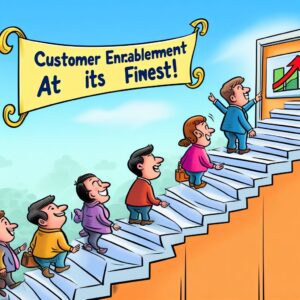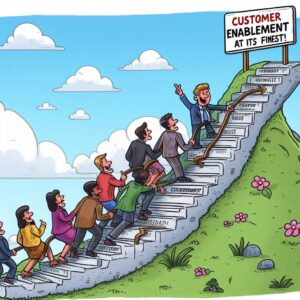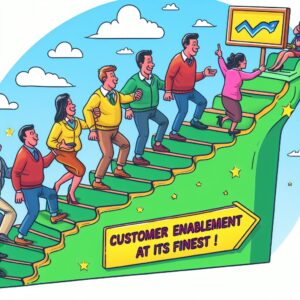Customer enablement is a strategic approach that organizations use to empower their customers to effectively and efficiently use their products or services. It’s about ensuring that customers can fully utilize the value that your product or service offers, and to do so in a way that is easy, efficient, and beneficial to them.
In the realm of business, customer enablement is a multifaceted process, beginning with a thorough comprehension of customer needs and expectations. It incorporates a diverse array of activities, from designing and implementing solutions that cater to these needs, to providing training, support, or resources that empower the customer to utilize the product or service more efficiently.
One of the fundamental components of customer enablement is the strategic utilization of technology. By harnessing technology, businesses can offer their customers a more personalized and streamlined experience. This could take the form of a software application tailored to the customer’s unique needs, or personalized recommendations derived from their usage patterns.
Moreover, it’s crucial to devise a customer enablement strategy that’s customized for each customer. This involves understanding the individual customer’s journey and experience, which in turn helps in better aligning the enablement strategy with their specific needs and preferences.
Another key aspect of customer enablement is the collection and implementation of customer feedback. By providing platforms for customers to share their experiences, businesses can gain valuable insights that can be used to enhance their enablement initiatives. Tools like Net Promoter Score (NPS) surveys can be used to measure customer loyalty and gather feedback, providing crucial data about the customer’s engagement level with the products and services.
Furthermore, it’s essential to integrate customers into your customer support process. Prioritizing customer success enablement ensures that users have all the necessary resources to make the most of your products or services. Knowledge base software can be instrumental in this regard, enabling you to create a searchable directory of the content for your enablement programs. This software also typically provides analytics and reporting, allowing customer service leaders and agents to understand how customers interact with the enablement resources.
Customer enablement is a comprehensive process that involves understanding customer needs, leveraging technology, personalizing the enablement strategy, collecting customer feedback, and incorporating customers into the support process. By effectively implementing these strategies, businesses can foster a more customer-centric culture, thereby enhancing customer satisfaction and loyalty.

The Importance of Customer Enablement
The concept of customer enablement has increasingly become a cornerstone in the business world, and its importance cannot be overstated. At its core, customer enablement is about empowering customers to extract the maximum possible value from a product or service, thereby fostering a sense of satisfaction, loyalty, and ultimately, driving revenue growth for the business.
A customer-centric approach, such as customer enablement, fundamentally enhances customer satisfaction. When customers perceive a product or service as user-friendly and tailored to their needs, they are not only more likely to continue using it, but are also more inclined to endorse it to others. This word-of-mouth marketing is a powerful tool, as customers are typically more inclined to trust recommendations from their peers.
Moreover, customer enablement is a potent driver of customer loyalty. Businesses that invest in enabling their customers to fully leverage their products or services build a strong foundation of trust and reliability. This, in turn, fosters a long-term relationship between the customer and the business, making customers more likely to stick with the business and its offerings over time.
Furthermore, customer enablement is a key contributor to a business’s revenue growth. By proactively helping customers derive the most value from their products or services, businesses not only ensure customer satisfaction but also stimulate repeat purchases and upselling opportunities. This approach not only increases the lifetime value of each customer but also bolsters the business’s bottom line.
Finally, customer enablement helps businesses to stay competitive in today’s fast-paced market. As customers become more knowledgeable and demanding, businesses that prioritize customer enablement are more likely to meet these evolving expectations, thereby gaining a competitive edge.
Customer enablement is a strategic business approach that offers manifold benefits, including enhanced customer satisfaction and loyalty, increased revenue, and competitive advantage. As such, businesses should consider it a key component of their overall strategy, investing time and resources to ensure that their customers are well-equipped to get the most out of their products or services.

Strategies for Customer Enablement
In the competitive business landscape, enabling customers is crucial for success. Here are some strategies that businesses can employ to ensure customer enablement:
- Prioritizing Superior Customer Service: This involves swiftly and professionally addressing customer inquiries and complaints. Proactive customer outreach is also essential in understanding their needs and alleviating their concerns.
- Providing Comprehensive Training and Support: To help customers effectively use a product or service, businesses can provide written guides, video tutorials, or live training sessions. This approach ensures that customers have the necessary resources to address any issues or questions they may have.
- Leveraging Technology for a Personalized Experience: Businesses can enhance the customer experience by leveraging technology. This might involve using software applications, mobile apps, or online platforms that allow customers to access and use the product or service conveniently and efficiently.
- Collecting and Analyzing Customer Feedback: Regularly collecting feedback from customers and analyzing it can reveal areas for improvement. These insights can be instrumental in enhancing the product or service and improving the overall customer experience.
- Personalizing the Customer Enablement Strategy: Each customer has unique needs and preferences. By personalizing the enablement strategy, businesses can ensure a more effective and satisfying experience for each customer.
- Implementing Customer Feedback: Providing avenues for customers to share their experiences can provide valuable data for support and customer success teams. This data can be used to strengthen enablement initiatives and address any knowledge gaps among customers.
- Utilizing AI in Customer Service: AI can be leveraged to improve both customer and employee experiences. It can help automate repetitive tasks and provide personalized customer interactions.
- Building a Customer-Centric Organization: A customer-centric organization prioritizes the needs and experiences of customers in all decision-making processes. This approach can help build long-term customer relationships and drive business growth.
- Scaling and Strengthening Customer Connections: As businesses expand, it becomes increasingly important to scale customer relationships and strengthen connections. This can be achieved by implementing effective customer success strategies.
- Empowering Users Through Education: By educating customers, businesses can empower them to make the most out of the product or service. This can lead to higher customer satisfaction and success.

Conclusion
In conclusion, customer enablement is a key aspect of business strategy. By understanding the needs and expectations of their customers, and by using technology and other strategies to meet these needs, businesses can provide a more effective and efficient experience for their customers. This can lead to increased customer satisfaction and loyalty, and ultimately, to increased revenue.
